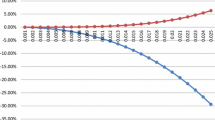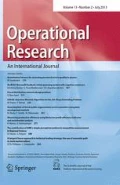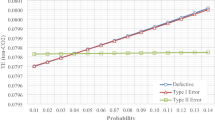Abstract
In real-life manufacturing systems, the presence of defective products in a lot is inevitable. While these products may be just scrapped in the food industry, in high-tech industries where the final product is very expensive, they may be reworked at a cost. A common assumption in the literature is that the inspection time needed to identify defective items is completed when the production process ends. However, the assumption of continuous inspection during production complicates the analysis, making it impractical for most production systems, especially when the production rate is high, and the proportion of defective items is low, making continuous inspection during production very expensive. In addition, such factors as process deterioration or other uncontrollable factors in the production process may interrupt the production of the lot. To address these practical issues, this paper integrates inspection time and the failure of production facilities into an imperfect production inventory model with rework, where the production run time is a decision variable and an inspection process continues even after a production run; the paper demonstrates significant effects on the optimal solutions, with shortages not allowed. Under these assumptions, a mathematical model is derived, and the concavity of the expected total profit function is proved. Optimal policy is obtained by applying the analytic method. Special cases of the model are studied and a numerical example with sensitivity analysis is provided to draw insights. Moreover, this numerical example is used to compare general and special cases.









Similar content being viewed by others

References
Abboud NE (1997) A simple approximation of the EMQ model with Poisson machine failures. Prod Plan Control 8(4):385–397
Abboud NE (2001) A discrete-time Markov production–inventory model with machine breakdowns. Comput Ind Eng 39:95–107
Berg M, Posner MJM, Zhao H (1994) Production–inventory systems with unreliable machines. Oper Res 421:111–118
Bielecki T, Kumar PR (1988) Optimality of zero-inventory policies for unreliable manufacturing systems. Oper Res 36(4):532–541
Boone T, Ganeshan R, Guo Y, Ord JK (2000) The impact of imperfect processes on production run times. Decis Sci 31(4):773–787
Cárdenas-Barrón LE (2009) Economic production quantity with rework process at a single-stage manufacturing system with planned backorders. Comput Ind Eng 57(3):1105–1113
Chakraborty T, Giri BC (2014) Lot sizing in a deteriorating production system under inspections, imperfect maintenance and reworks. Oper Res Int J 14(1):29–50
Chakraborty T, Giri BC, Chaudhari KS (2008) Production lot sizing with process deterioration and machine breakdown. Eur J Oper Res 185(2):606–618
Chan WM, Ibrahim RN, Lochert PB (2003) A new EPQ model: integrating lower pricing, rework and reject situations. Prod Plan Control 14(7):588–595
Chiu YP (2003) Determining the optimal lot size for the finite production model with random defective rate, the rework process, and backlogging. Eng Optim 35(4):427–437
Chiu SW, Wang SL, Chiu YSP (2007) Determining the optimal run time for EPQ model with scrap, rework, and stochastic breakdowns. Eur J Oper Res 180:664–676
Chiu YSP, Lin HD, Chang HH (2011) Mathematical modeling for solving manufacturing run time problem with defective rate and random machine breakdown. Comput Ind Eng 60(4):576–584
Chiu SW, Chou CL, Wu WK (2013) Optimizing replenishment policy in an EPQ-based inventory model with nonconforming items and breakdown. Econ Model 35:330–337
Chiu SW, Lin HD, Song MS, Chen HM, Chiu YSP (2015) An extended EPQ-based problem with a discontinuous delivery policy, scrap rate, and random breakdown. Sci World J. https://doi.org/10.1155/2015/621978
Chung KJ (1997) Bounds for production lot sizing with machine breakdowns. Comput Ind Eng 32(1):139–144
Chung KJ (2003) Approximations to production lot sizing with machine breakdowns. Comput Oper Res 30(10):1499–1507
Chung KJ, Hou KL (2003) An optimal production run time with imperfect production processes and allowable shortages. Comput Oper Res 30(4):483–490
Flapper SDP, Teunter RH (2004) Logistic planning of rework with deteriorating work-in-process. Int J Prod Econ 88:51–59
Flapper SDP, Fransoo JC, Broekmeulen RACM, Inderfurth K (2002) Planning and control of rework in the process industries: a review. Prod Plan Control 13(1):26–34
Giri BC, Dohi T (2006) Optimal inspection schedule in an imperfect EMQ model with free repair warranty policy. J Oper Res Soc Jpn 49(3):222–237
Glock CH (2013) The machine breakdown paradox: how random shifts in the production rate may increase company profits. Comput Ind Eng 66:1171–1176
Glock CH, Jaber MY (2013a) An economic production quantity (EPQ) model for a customer-dominated supply chain with defective items, reworking and scrap. Int J Serv Oper Manag 14:236–251
Glock CH, Jaber MY (2013b) A multi-stage production-inventory model with learning and forgetting effects, rework and scrap. Comput Ind Eng 64:708–720
Groenevelt H, Pintelon L, Seidmann A (1992) Production lot sizing with machine breakdowns. Manag Sci 38(1):104–123
Gupta T, Chakraborty S (1984) Looping in a multistage production system. Int J Prod Res 22(2):299–311
Hayek PA, Salameh MK (2001) Production lot sizing with the reworking of imperfect quality items produced. Prod Plan Control 12(6):584–590
Hsu JT, Hsu LF (2013) Two EPQ models with imperfect production process, inspection errors, planned backorders, and sales returns. Comput Ind Eng 64(1):389–402
Hsu LF, Hsu JT (2015) Economic production quantity (EPQ) models under an imperfect production process with shortages backordered. Int J Syst Sci 47(4):852–867
Huang H, He Y, Li D (2017) EPQ for an unreliable production system with endogenous reliability and product deterioration. Int Trans Oper Res 24:839–866
Inderfurth K, Janiak A, Kovalyov MY, Werner F (2006) Batching work and rework processes with limited deterioration of reworkables. Comput Oper Res 33:1595–1605
Jamal AMM, Sarker BR, Mondal S (2004) Optimal manufacturing batch size with rework process at a single-stage production system. Comput Ind Eng 47(1):77–89
Khan M, Jaber MY, Guiffrida AL, Zolfaghari S (2011) A review of the extensions of a modified EOQ model for imperfect quality items. Int J Prod Econ 132:1–12
Kontantaras I, Goyal SK, Papachristos S (2007) Economic ordering policy for an item with imperfect quality subject to the in-house inspection. Int J Syst Sci 38(6):473–482
Lee HL, Rosenblatt MJ (1987) Simultaneous determination of production cycle and inspection schedules in a production system. Manag Sci 33(9):1125–1136
Li N, Chan FTS, Chung SH, Tai AH (2015) An EPQ model for deteriorating production system and items with rework. Math Probl Eng. https://doi.org/10.1155/2015/957970
Liao GL (2016) Optimal economic production quantity policy for a parallel system with repair, rework, free-repair warranty and maintenance. Int J Prod Res 54(20):6265–6280
Lin GC, Gong DC (2006) On a production-inventory system of deteriorating items subject to random machine breakdowns with a fixed repair time. Math Comput Model 43(7–8):920–932
Lin GC, Kroll DE (2006) Economic lot sizing for an imperfect production system subject to random breakdowns. Eng Optim 38(1):73–92
Lin GC, Lin HD (2007) Determining a production run time for an imperfect production–inventory system with scrap. J Sci Ind Res 66:724–735
Liu B, Cao J (1999) Analysis of a production–inventory system with machine breakdowns and shutdowns. Comput Oper Res 20(1):73–91
Liu JJ, Yang P (1996) Optimal lot-sizing in an imperfect production system with homogeneous reworkable jobs. Eur J Oper Res 91:517–527
Liu N, Kim Y, Hwang H (2009) An optimal operating policy for the production system with rework. Comput Ind Eng 56:874–887
Ma WN, Gong DC, Lin GC (2010) An optimal common production cycle time for imperfect production processes with scrap. Math Comput Model 52:724–737
Maddah B, Salameh MK, Karame GM (2009) Lot sizing with random yield and different qualities. Appl Math Model 33(4):1997–2009
Moinzadeh K, Aggarwal P (1997) Analysis of a production/inventory system subject to random disruptions. Manag Sci 43(11):1577–1588
Mokhtari H (2018) A joint international production and external supplier order lot size optimization under defective manufacturing and rework. Int J Adv Manuf Technol 95(1–4):1039–1058
Moussawi-Haidar L, Salameh M, Nasr W (2016) Production lot sizing with quality screening and rework. Appl Math Model 40:3242–3256
Nobil AH, Sedigh AHA, Tiwari S, Wee HM (2018) An imperfect multi-item single machine production system with shortage, rework, and scrapped considering inspection, dissimilar deficiency levels, and non-zero setup times. Scientia Iranica. https://doi.org/10.24200/sci.2018.4984.1031
Öztürk H (2017) A note on “Production lot sizing with quality screening and rework”. Appl Math Model 43:659–669
Porteus EL (1986) Optimal lot sizing, process quality improvement and setup cost reduction. Oper Res 34:137–144
Rezaei J (2016) Economic order quantity and sampling inspection plans for imperfect items. Comput Ind Eng 96:1–7
Rosenblatt MJ, Lee HL (1986) Economic production cycles with imperfect production processes. IIE Trans 18(1):48–55
Salameh MK, Jaber MY (2000) Economic production quantity model for items with imperfect quality. Int J Prod Econ 64:59–64
Sarkar B, Cárdenas-Barrón LE, Sarkar M, Singgih ML (2014) An economic production quantity model with random defective rate, rework process and backorders for a single stage production system. J Manuf Syst 33(3):423–435
Sharafali M (1984) On a continuous review production–inventory problem. Oper Res Lett 3(4):199–204
Shih W (1980) Optimal inventory policies when stockouts result from defective products. Int J Prod Res 18(6):677–686
Suntag C (1993) Inspection and inspection quality management. ASQC, Milwaukee
Tai AH (2013) Economic production quantity models for deteriorating/imperfect products and service with rework. Comput Ind Eng 66:879–888
Taleizadeh AA, Cárdenas-Barrón LE, Mohammadi B (2014) A deterministic multi product single machine EPQ model with backordering, scraped products, rework and interruption in manufacturing. Int J Prod Econ 150:9–27
Taleizadeh AA, Sari-Khanbaglo MP, Cárdenas-Barrón LE (2017) Outsourcing rework of imperfect items in the economic production quantity (EPQ) inventory model with backordered demand. IEEE Trans Syst Man Cybern Syst. https://doi.org/10.1109/tsmc.2017.2778943
Ting CK, Chiu YSP, Chan CCH (2011) Optimal lot sizing with scrap and random breakdown occurring in backorder replenishing period. Math Comput Appl 16(2):329–339
Tsao YC, Chen TH, Huang SM (2011) A production policy considering reworking of imperfect items and trade credit. Flex Serv Manuf J 23:48–63
Wazwaz AM (2011) Linear and nonlinear integral equations. Springer, Beijing
Wee HM, Widyadana GA (2013) A production model for deteriorating items with stochastic preventive maintenance time and rework process with FIFO rule. Omega 41(6):941–954
Wee HM, Wang WT, Cárdenas-Barrón LE (2013) An alternative analysis and solution procedure for the EPQ model with rework process at a single-stage manufacturing system with planned backorders. Comput Ind Eng 64(2):748–755
Wee HM, Wang WT, Kuo TC, Cheng YL, Huang YD (2014) An economic production quantity model with non-synchronized screening and rework. Appl Math Comput 233:127–138
Widyadana GA, Wee HM (2011) Optimal deteriorating items production inventory models with random machine breakdown and stochastic repair time. Appl Math Model 35:3495–3508
Widyadana GA, Wee HM (2012) An economic production quantity model for deteriorating items with preventive maintenance policy and random machine breakdown. Int J Syst Sci 43(10):1870–1882
Yoo SH, Kim DS, Park MS (2009) Economic production quantity model with imperfect-quality items, two-way imperfect inspection and sales return. Int J Prod Econ 121(1):255–265
Zhang X, Gerchak Y (1990) Joint lot sizing and inspection policy in an EOQ model with random yield. IIE Trans 22(1):41–47
Acknowledgements
The author expresses sincere appreciation to the editor and anonymous reviewers for their efforts to improve the quality of this paper.
Author information
Authors and Affiliations
Corresponding author
Appendix: Derivation of the mathematical equations
Appendix: Derivation of the mathematical equations
The total cost per cycle in (20) includes the production setup cost, the production cost, machine repair cost, inspection cost during and after production, disposal cost, reworking cost and holding cost, which is given as:
Then the first, second, third, fourth, fifth and sixth parts of the eighth term of \(TC_{1} \left( {T_{1} } \right)\) become the following equations, respectively:
In addition, the ninth and tenth terms of \(TC\left( {T_{1} } \right)\) become the following equations, respectively:
Substituting these equations in (44), we have total inventory cost per cycle as
Rights and permissions
About this article
Cite this article
Öztürk, H. Optimal production run time for an imperfect production inventory system with rework, random breakdowns and inspection costs. Oper Res Int J 21, 167–204 (2021). https://doi.org/10.1007/s12351-018-0439-5
Received:
Revised:
Accepted:
Published:
Issue Date:
DOI: https://doi.org/10.1007/s12351-018-0439-5



